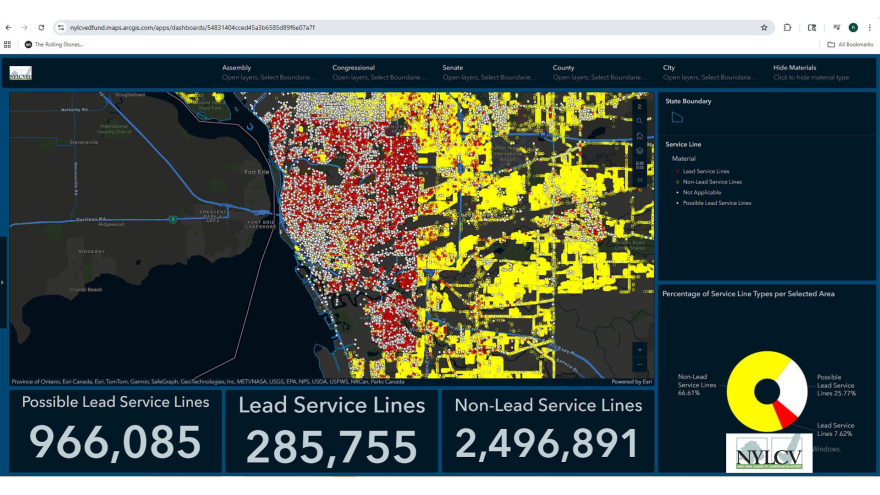As municipalities, water authorities and homeowners are grappling with ridding infrastructure of the health risk that lead water service lines can pose, there are still two major obstacles – logistics and money.
The New York League of Conservation Voters has just released an interactive map outlining the entirety of the state’s water service lines, and whether they’re made of non-lead, lead or possible lead materials. It’s a compilation of data collected by a plethora of government agencies, serving as a one stop shop no matter where you live.
Its revelations are stark, around 3.1 million people in New York receive their drinking water through confirmed or suspected lead pipes. That’s 15% of the state’s population. Buffalo has the highest confirmed percentage for major cities outside of New York City at 45%.
“What's equally heartbreaking is that there's an equal amount, another 45% where it's unknown, and there's going to be a good portion of those that will be discovered,” said Joshua Klainberg, senior vice president of the New York League of Conservation Voters.

Klainberg said while Buffalo’s data certainly leads the pack, lead pipes and their associated health hazards hit communities large and small, rural and urban, wealthy and impoverished. NYLCV's data map shows about one in three service lines in the state are made of lead or possible lead.
Federal rules require replacement work to begin in 2027 and finish by 2037. Many towns and cities have already started, and while New York has set up a grant program, there’s currently no state guidelines for when or what they’re replaced with – or who foots the bill. Klainberg believes that needs to change.
“You have some communities that are working with homeowners to share the costs, and others that are just giving the entire bill to the homeowners, sticking them with it," he said. "You have some communities that are using plastic piping, other that are using copper. You have all these different modes and methods for doing this.”
That advocacy for more state support is echoed by Jerome Schad, chairman of the Erie County Water Authority. Their district does not include the city of Buffalo, but many neighboring and outlying communities. He says about 90% of their requests are denied.
“The criteria itself is very fair in terms of equities, of who's the poorest community, who's the neediest, but we happen to be a large system," said Schad. "We have a number of affluent neighborhoods, and we have a number of very unaffluent neighborhoods, but we're measured by the totality, and so we often do not get approved because we don't hit the mean level of need.”
Schad said the Erie County Water Authority has already begun work on replacing lead service lines. He told BTPM NPR that there's been "several hundred" replaced so far this year, with an increased pace planned for next year. That work has already racked up to $15 million.
In 1981, a few years before lead pipes were officially banned in the U.S., the federal government allocated $25 billion towards water infrastructure, almost half of total investment in the area. By 2021 that amount had dwindled down to $4 billion, leaving the vast majority to state's and municipalities to bear. The Infrastructure Improvement and Jobs Act passed the same year, putting that number up to $55 billion, but Klainberg said that money is slated to run out by the end of next year.
“As the federal money winds down over the next year and a half, and as we get to that two year point where the 10-year starting gun fires, this is really a wake up call now to have the policies and the public financing in place," Klainberg said. "[Make] this is a seamless transition, and we can remove all lead pipes quickly, cost efficiently and also, importantly, very equitably,”
Right now for Erie County Water customers, the authority’s chairman said the cost of replacement is being carried mostly by them.
“We are optimistic that we're going to succeed on getting all the lead out, and we're going to keep asking every year to get financial support from the state to help us," said Schad.
According to the EPA, long term exposure to lead can lead to health risks from headaches and joint pain to nerve and brain damage. Children are at higher risk for lead poisoning, because their growing bodies tend to absorb more of the toxin.
If you believe your home has lead pipes, you can call your local water authority. Klainberg said doing things like running your water after long periods of non-use, only using cold water to cook and buying a lead certified filtration cartridge can help.






